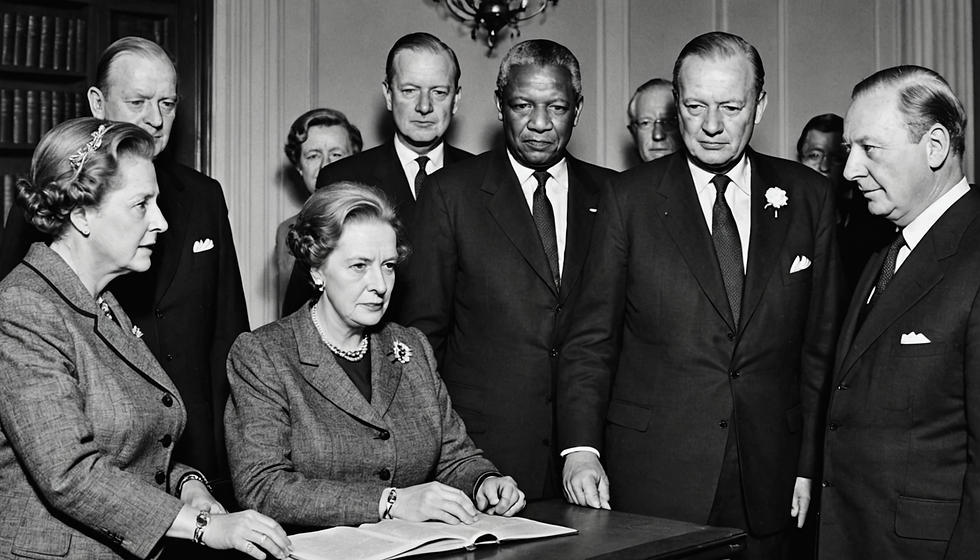Canada vs. U.S. trade wars: Use of power & influence tactics baseline conflict analysis
- R.M. Boylan

- Feb 15
- 3 min read
Updated: Mar 1
Rose-Marie Boylan
BSc. M.A. Leadership Studies

Baseline conflict analysis of "power sources" & "influence tactics" deployed
This negotiation analysis of the USA vs. Canada trade wars conflict looks at forms of "Power" being used & "weapons of influence" suggesting how to improve the conflict
The 6 weapons of influence include 1). Reciprocity 2). Commitment & Consistency 3). Social proof 4). Liking 5). Authority 6). Scarcity (Cialdini, R.B. 1993) These are merged in a negotiation strategy with the different forms of power that are most effective for deployment. In the conflict between USA and Canada a disproportionate use of "coercive power" is being used as the power source which is escalating conflict on both sides.
This analysis is not to critique Mr. Trump & Canada but rather shed light on how a negotiation strategy & plan could improve the situation as it escalates in incivility. I also discuss the relevance of our human/animal need to use coercive power to harm & dominate others to get our way in negotiations or conflicts. I also want to discuss more the relevance of our human/animal need to use coercive power to harm & dominate others to get our way in negotiations or conflicts. This is a natural tendency for all of us when there is stress arousal or a threat of basic need deprivation. The unconscious psyche is a sleeping volcano which reacts in certain manners not appropriate to negotiating between allies and partners.
The analysis critically reviews current "power sources" being deployed in the conflict & satellite influence tactics. It demonstrates that a disproportionate use of "coercive power" is being deployed on both sides as offence strategies & retaliatory tactics.
We have a great deal to gain on how we can improve in our daily and work related negotiations by understanding how humans use these principles to get what they want. Similarly, understanding how more appropriate & evolved strategies and tactics can be leveraged to create a win-win situation.
Managing our human/animal need to use coercive power to get results
"Coercive power is based on the ability to force compliance through threats or punishment." (Raven, B.H. 2008) This power can create fear, animosity and rebellion among partners and followers. In order to be effective in leadership and/or negotiations the use of coercive power should be at 10% maximum or not used at all depending on the context. It destroys trust and long-term progress within relationships between humans.
It is intriguing because, as we examine the dynamics between Canada and the USA, we can identify how certain "influence" factors might be strategically utilized to enhance the situation. As I've mentioned, the trade war conflict between Canada and the USA has yet to progress to a negotiation stage. It remains a contentious bargaining scenario with increasing incivility.
The current situation between the USA and Canada involves a confrontational bargaining focused on "positions" rather than "interests," where coercive power is employed to achieve the desired outcome. Only 10% of the most effective types of "power" are being utilized to their full extent. Likewise, coercive power is being used to artificially create the "scarcity" principle.
It's crucial to recognize that Malsow's research and my research on leadership revealed that fewer than 1% of people can experience basic need deprivation without developing psychopathologies. The artificial creation of "scarcity" for a nation and its citizens leads to harm, violence, and chaos, weakening the society's infrastructure from within. The combination of coercive power and engineered scarcity through retaliatory economic sanctions is detrimental to both American and Canadian civilians. For the benefit of the people, it would be mutually advantageous for the USA and Canada to adopt a negotiation strategy that considers each side's perspective. Only then can a solution with trade-offs be reached, fostering a partnership between these two great nations.
Both nations and their citizens will experience "scarcity" unless there is a shift in "power" sources and the adoption of more ethical methods of influence to obtain what each side needs and desires. In other words, achieving a "win-win" situation in this escalating conflict is becoming increasingly unclear and unattainable due to those engaged in the struggle.
Background of coercive power
Definition: Coercive power is based on the ability to force compliance through threats or punishment. This power can create fear among followers.
Percentage Importance: 10%
References: Raven, B.H. (2008). "The Bases of Power and Power/Interaction Model of Interpersonal Influence." Analyses of Social Issues and Public Policy.
Effective Use: Coercive power can be seen in military contexts where compliance is necessary for operational success.






Comments